Keeping abreast of all the dynamic growth and trends in the flooring industry is a daunting task. There always seems to be something new to learn.
One of the fastest growing segments of the flooring industry is concrete floors. Yes, concrete floors, believe it or not. While concrete has been around since the time of the Romans, it has traditionally been used as a core building material, an unfinished floor, or as a substrate for another flooring system.
The inherent flaws with unfinished concrete floors include dust, loose granules of sand, loose or missing aggregate in the surface, spalled surfaces, cracks, seams, blotchy appearance, etc. The list goes on. Regardless, we are now seeing a huge growth in the use of concrete floors as the “finished floor” itself.
Diamond polishing concrete floors can create gorgeous, mirror-like floors that take a minimal amount of care to maintain. In fact, the minimal amount of care required for polished concrete floors has become part of their appeal. I say minimal, because they still require cleaning. After all, they are not self-cleaning floors. The good news is that you can clean polished concrete floors with many different chemicals, most specifically, products like pH-neutral cleaners, mildly alkaline cleaners, or even bio-enzymatic cleaners. Just make sure to follow the manufacturer’s guidelines, as not all concrete floors are created equal.
Polishing Concrete for Show
If the idea of a gorgeous, mirror-like concrete floor appeals to you, you’re not alone. Be aware, properly polishing concrete floors is not easy. It requires multiple steps that are quite sophisticated. First steps include proper preparation of the concrete floor through cleaning, degreasing, scarification, or grinding in order to level the floor surface and remove any contaminants. The next step is to use a sodium-based, potassium-based, lithium-based, or silica-based densifier (or hardening agent) and/or colored dyes. Now, and only now, the stage is set for diamond polishing.
Diamond polishing incorporates multiple steps of its own. These steps include wet polishing with as few as three different levels (or grits) of diamond pads to as many as seven levels (or grits) of diamond pads, depending on the system and the desired level of gloss. (Not everyone wants or needs a perfect mirror finish.) The final step requires dry burnishing with special diamond-infused floor pads mounted on ultra high-speed burnishers. The result is often spectacular.
With that said, polished concrete can serve as a purely functional and good-looking floor. Different levels of finish—matte, satin, or high-gloss—can be applied, as well, depending on how you intend to use them.
When to Avoid Polishing
Not all concrete floors are good candidates for polishing. Some concrete floors may appear wavy with hills and valleys, due to the way the concrete was originally installed and troweled. In fact, concrete floors can vary radically in hardness.
Some concrete floors are referred to as “hard,” yet others may be “soft.” This happens as a result of the original formulation used to make the concrete, as well as its age and other factors. These are all variables that you may have no control over, especially if the concrete floor is quite old. In that case, you may need to look at some traditional concrete coating systems.
Other Coatings
Over the years, many kinds of specialized coatings were used on concrete floors. Polymer-based coatings such as acrylics, urethanes, methyl methacrylate (MMA), and epoxies have all been used, each for different reasons.
- Acrylic
Acrylics provided a way of limiting the amount of dusting that naturally occurs with unfinished concrete. Warehouses have been prime candidates for acrylic coatings. These would wear out rather quickly, requiring annual or biannual refinishing.
- Urethane
Various urethane products have been used over the years, from oil-modified urethanes, which are not vastly different than gym floor finishes, to chemical-resistant urethanes. These were once popular in aircraft hangars and car dealerships, and even some warehousing applications. Although urethane-coated concrete floors were glossy and easy to clean, they were noted for discoloring, yellowing, chipping and peeling.
- Epoxy
Some of the most advanced coatings for concrete are in the epoxy family. Epoxies have been used as a purely resinous system to cover concrete floors and are often pigmented to hide blemishes in the concrete itself. These systems can be finished with a smooth, glossy look, or they can have antislip aggregates broadcast into them, which provide enhanced antislip characteristics. These floors tend to be very popular in service bays of automotive dealerships, garages, and even vehicle or pedestrian ramps.
- Decorative Epoxy
Color-quartz epoxy floors are made of clear epoxy resins that have tiny, multicolored quartz aggregate broadcast into them while the floors are still wet and uncured. Multiflake epoxy floors use concrete with small chips or flakes of multicolored material broadcast into them.
Color-quartz and multiflake epoxy floors became very popular for commercial kitchens, biotech firms, and hospital operating rooms. They have even been used in large bathrooms or shower rooms, and are still popular now. In fact, homeowners have embraced these systems for their garages or basements. These floors are often seamless, which prevents soils, mold, and mildew from building up in cracks and seams. Also, they often incorporate a monolithic-cove base that helps to eliminate the danger of water unintentionally migrating into the edge of the floor where it meets the base of the wall.
Opportunity in Concrete
Concrete floors have opened vast opportunities for all types of businesses and industries. Perhaps, the concrete floor, one of the oldest floors known to man, is now evolving into the floor of the future. Only time will tell.



